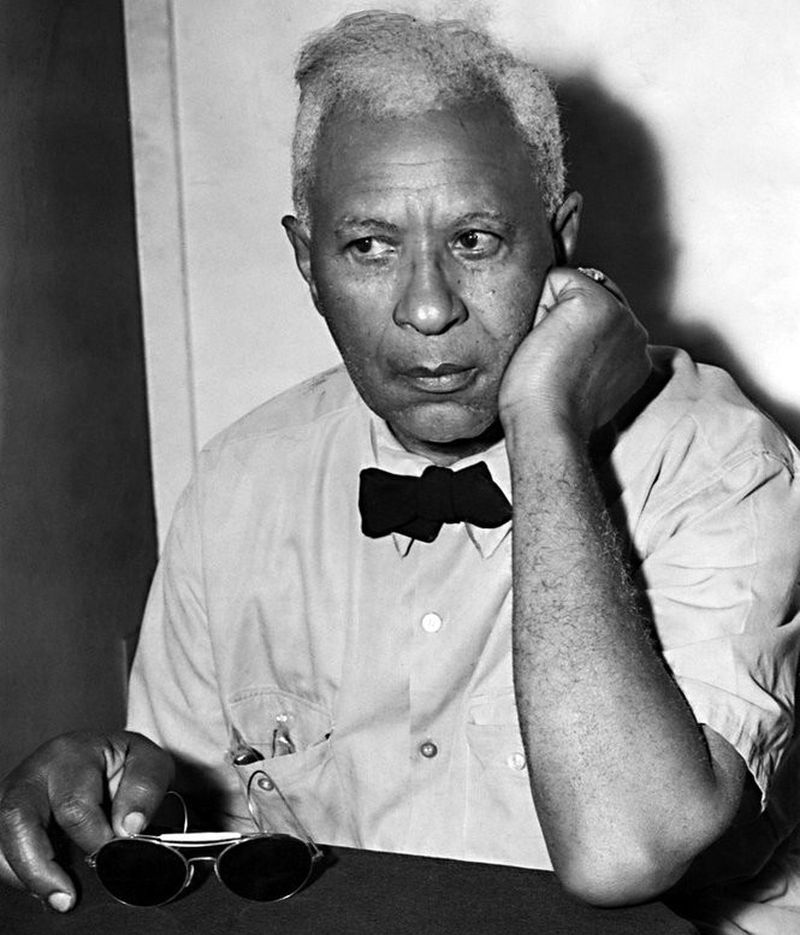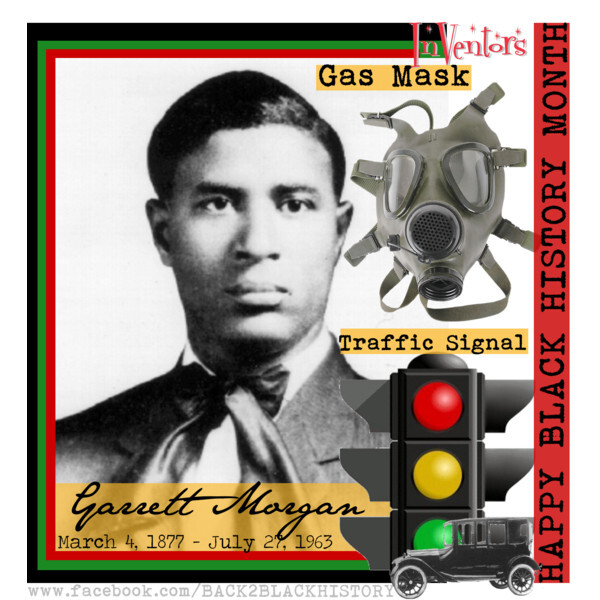Celebrating Black History Month: Garrett Morgan
Who
Was
Garrett
Morgan?
With only an elementary school education, Garrett Morgan began his career as a sewing-machine mechanic. He went on to patent several inventions, including an improved sewing machine and traffic signal, a hair-straightening product, and a respiratory device that would later provide the blueprint for WWI gas masks. The inventor died on July 27, 1963, in Cleveland, Ohio.
Early Life
Born in Paris, Kentucky, on March 4, 1877, Garrett Morgan was the seventh of 11 children. His mother, Elizabeth Reed, was of Indian and African descent, and the daughter of a Baptist minister. His father, Sydney, a formerly enslaved person freed in 1863, was the son of John Hunt Morgan, a Confederate colonel. Morgan's mixed-race heritage would play a part in his business dealings as an adult.
When Morgan was in his mid-teens, he moved to Cincinnati, Ohio, to look for work, and found it as a handyman to a wealthy landowner. Although he only completed an elementary school education, Morgan was able to pay for more lessons from a private tutor. But jobs at several sewing-machine factories were to soon capture his imagination and determine his future. Learning the inner workings of the machines and how to fix them, Morgan obtained a patent for an improved sewing machine and opened his own repair business.
Morgan's
business
was
a
success,
and
it
enabled
him
to
marry
a
Bavarian
woman
named
Mary
Anne
Hassek,
and
establish
himself
in
Cleveland.
(He
and
his
wife
would
have
three
sons
during
their
marriage.)
G.A. Morgan Hair Refining Company
Following the momentum of his business success, Morgan's patented sewing machine would soon pave the way to his financial freedom, albeit in a rather unorthodox way: In 1909, Morgan was working with sewing machines in his newly opened tailoring shop — a business he had opened with wife Mary, who had experience as a seamstress — when he encountered woolen fabric that had been scorched by a sewing-machine needle. It was a common problem at the time since sewing-machine needles ran at such high speeds. In hopes of alleviating the problem, Morgan experimented with a chemical solution in an effort to reduce friction created by the needle and subsequently noticed that the hairs of the cloth were straighter.
After trying his solution to good effect on a neighboring dog's fur, Morgan finally tested the concoction on himself. When that worked, he quickly established the G.A. Morgan Hair Refining Company and sold the cream to African Americans. The company was incredibly successful, bringing Morgan financial security and allowing him to pursue other interests.
Inventions:
Breathing
Device
In 1914, Morgan patented a breathing device, or "safety hood," providing its wearers with a safer breathing experience in the presence of smoke, gases and other pollutants. Morgan worked hard to market the device, especially to fire departments, often personally demonstrating its reliability in fires. Morgan's breathing device became the prototype and precursor for the gas masks used during World War I, protecting soldiers from toxic gas used in warfare. The invention earned him the first prize at the Second International Exposition of Safety and Sanitation in New York City.
READ
NEXT
Sadie
Tanner
Mossell
AlexanderSadie
Tanner
Mossell
Alexander,
1954.
(Photo
by
Afro
American
Newspapers/Gado/Getty
Images)
Sadie
Alexander
(1898–1989)
Adrienne
KennedyAmerican
playwright
Adrienne
Kennedy,
UK,
11th
August
1967.
(Photo
by
Evening
Standard/Hulton
Archive/Getty
Images)
Adrienne
Kennedy
(1931–)
6th
Annual
InStyle
Awards
-
ArrivalsLOS
ANGELES,
CALIFORNIA
-
NOVEMBER
15:
Amanda
Gorman
attends
the
6th
Annual
InStyle
Awards
on
November
15,
2021
in
Los
Angeles,
California.
(Photo
by
Frazer
Harrison/Getty
Images)
Amanda
Gorman
(1998–)
There
was
some
resistance
to
Morgan's
devices
among
buyers,
particularly
in
the
South,
where
racial
tension
remained
palpable
despite
advancements
in
African
American
rights.
In
an
effort
to
counteract
the
resistance
to
his
products,
Morgan
hired
a
white
actor
to
pose
as
"the
inventor"
during
presentations
of
his
breathing
device;
Morgan
would
pose
as
the
inventor's
sidekick,
disguised
as
a
Native
American
man
named
"Big
Chief
Mason,"
and,
wearing
his
hood,
enter
areas
otherwise
unsafe
for
breathing.
The
tactic
was
successful;
sales
of
the
device
were
brisk,
especially
from
firefighters
and
rescue
workers.
Cleveland Tunnel Explosion
In 1916, the city of Cleveland was drilling a new tunnel under Lake Erie for a fresh water supply. Workers hit a pocket of natural gas, which resulted in a huge explosion and trapped workers underground amidst suffocating noxious fumes and dust. When Morgan heard about the explosion, he and his brother put on breathing devices, made their way to the tunnel and entered as quickly as possible. The brothers managed to save two lives and recover four bodies before the rescue effort was shut down.
Despite his heroic efforts, the publicity that Morgan garnered from the incident hurt sales; the public was now fully aware that Morgan was an African American, and many refused to purchase his products. Adding to the detriment, neither the inventor nor his brother were fully recognized for their heroic efforts at Lake Erie — possibly another effect of racial discrimination. Morgan was nominated for a Carnegie Medal for his efforts, but ultimately wasn't chosen to receive the award. Additionally, some reports of the explosion named others as the rescuers.
Later Inventions: Traffic Light
While the public's lack of acknowledgment for Morgan's and his brother's roles at the Cleveland explosion was undoubtedly disheartening, Morgan was a voracious inventor and observer who focused on fixing problems and soon turned his attention to all kinds of things, from hats to belt fasteners to car parts.
The first Black man in Cleveland to own a car, Morgan worked on his mechanical skills and developed a friction drive clutch. Then, in 1923, he created a new kind of traffic signal, one with a warning light to alert drivers that they would need to stop, after witnessing a carriage accident at a particularly problematic intersection in the city. Morgan quickly acquired patents for his traffic signal—a rudimentary version of the modern three-way traffic light—in the United States, Britain and Canada, but eventually sold the rights to General Electric for $40,000.
Social Activism
Outside of his inventing career, Morgan diligently supported the African American community throughout his lifetime. He was a member of the newly formed National Association for the Advancement of Colored People, was active in the Cleveland Association of Colored Men, donated to Negro colleges and opened an all-Black country club. Additionally, in 1920, he launched the African American newspaper the Cleveland Call (later named the Call and Post).
Death and Legacy
Morgan began developing glaucoma in 1943 and lost most of his sight as a result. The accomplished inventor died in Cleveland, Ohio, on July 27, 1963, shortly before the celebration of the Emancipation Proclamation centennial, an event he had been awaiting. Just before his death, Morgan was honored by the U.S. government for his traffic signal invention, and he was eventually restored to his place in history as a hero of the Lake Erie rescue.
Morgan improved and saved countless lives worldwide, including those of firefighters, soldiers and vehicle operators, with his profound inventions. His work provided the blueprint for many important advancements that came later and continues to inspire and serve as a basis for research conducted by modern-day inventors and engineers.
Testimonials
-
Curtis Benjamin
-
Brenda PryorMyCom Coordinator
-
Brandan NewtonAnton Grdina FLOW Participant
MyCom will enact our mission with race and equality at the forefront of our work as we always have. We will use our thought-leadership, funding, advocacy, and network to redesign service delivery. Together we will rethink infrastructure and create solutions that eliminate access to healthcare, cyclical poverty, access to quality education, housing stability, and other barriers that have impacted black lives.

